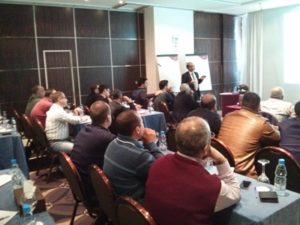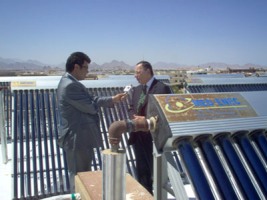Lebanon: Check List for Solar Installations in Hospitals
January 20, 2010Saida Governmental Hospital
The demonstration of best practise – a solar thermal system on the roof of the Saida Governmental Hospital – showed some technical deficiencies at second glance. The monitoring of the system led to a check list including preventive maintenance advice.
Photo: Solarnet
Solar water heating systems can substantially reduce the energy bills of healthcare facilities. Only, designers and installers faced and still face complex requirements, for example when they installed solar water heating systems on hospitals in Lebanon as part of the Country Energy Efficiency and Renewable Energy Demonstration Project for the Recovery of Lebanon (CEDRO).
The project is funded by the Lebanese government and grants from Spain and started in 2007. So far, the project had four solar thermal systems installed on public hospitals, all of them with a daily capacity of 4,000 litres of solar-heated water: Abdallah Rassi, Hermel, Jezzine and Saida. CEDRO monitored the systems and created a list of technical failures and best practises. It presented the results at a workshop in Beirut, Lebanon, in October 2009. There, 60 participants listened to the presentation of Jean Paul Sfeir, Manager of Solarnet, a Lebanese solar water heater company participating in the Lebanese Centre for Energy Conservation (LCEC) project.
According to Sfeir, the biggest problem of the system was the leakage in the automated air vent, which not only caused the system to overheat, but also showed its low product quality. The next biggest problems were the heat exchanger and also the piping insulation. And if that were not enough, absorbers and pipes were leaking, the glass was broken and both the solar controller and the circulation pump had been damaged. In order to avoid those failures in the future, CEDRO created a check list including preventive maintenance advice, which ranges from cleaning the collectors to checking controllers. Download the attached presentation to learn more about the aforementioned issues.
Nader Hajj Shehadeh, Energy Engineer from LCEC, held another interesting presentation on significant technical problems. Its title: “Solar Water Heating Applications: 2,310 m² installed, Valuable Lessons Learned”. His analysis was based on two different projects: the 500 residential solar water heaters donated by China in 2006 and the 104 solar water heaters funded by Sweden for the July War Recovery project, which was realised in 2007/2008.
The main problems were classified in three categories: mechanical, electrical and monitoring. The mechanical problems mainly stemmed from improper piping, high water pressure, cracking pipes, and improper insulations. As for the electrical difficulties, improper positions of tank temperature sensors, inaccurate readings of controllers, and untidy cabling were the main sources of system failures. Monitoring mishaps included misplaced flow, unshielded cables, taped connections and insufficient labelling. The engineer not only pointed out failures, but also made proposals on how to prevent deficiencies from occurring a second time. Download the attached presentation to see his report in detail.
More Information:
http://www.cedro-undp.org/en/news/details/?newsid=7
http://www.solarnet-online.com/index.asp
Text was written by communication expert Hanna Schober based in South Africa.
Schober@solrico.com
Schober@solrico.com


